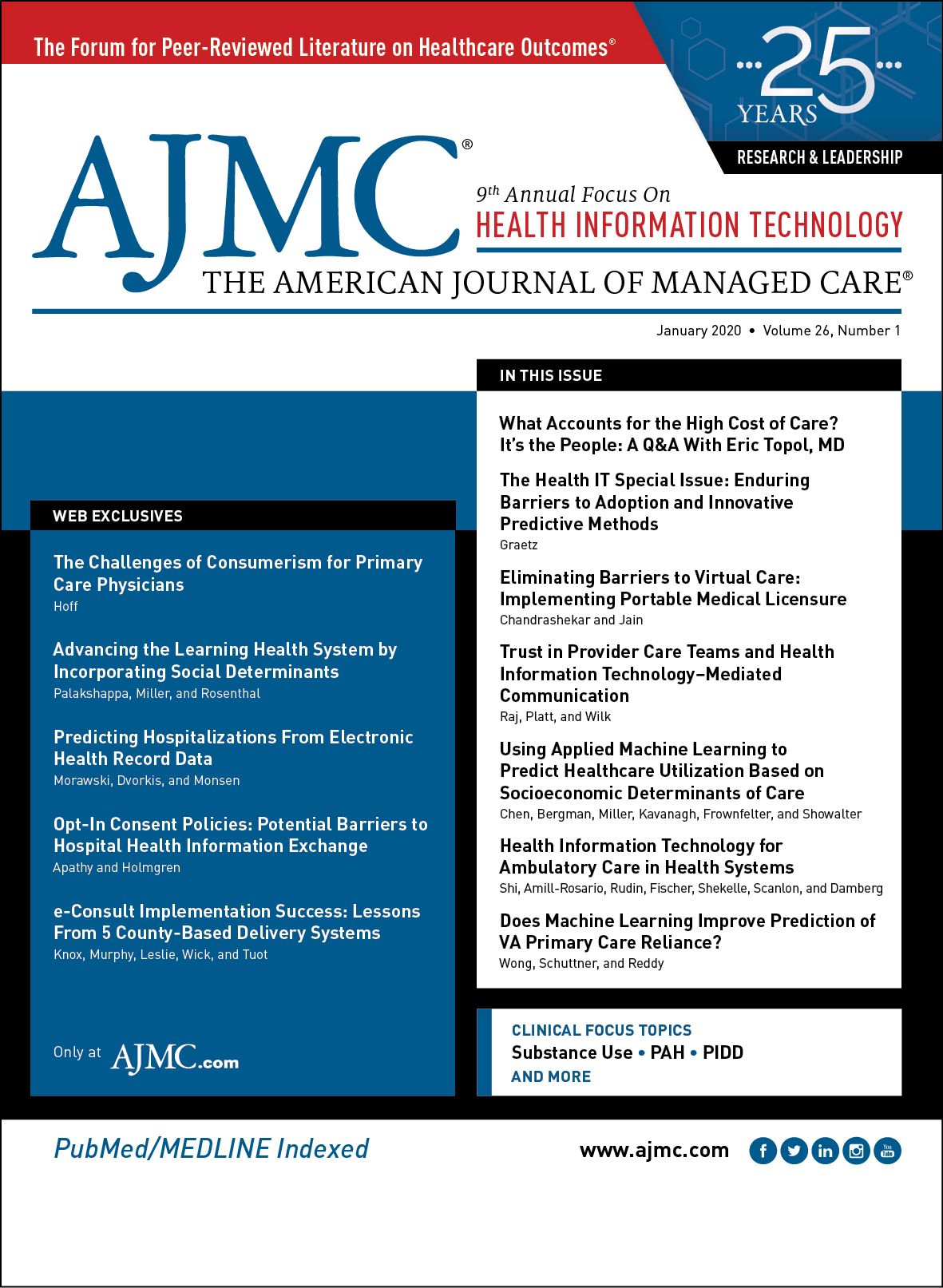Publication
Article
The American Journal of Managed Care
The Health IT Special Issue: Enduring Barriers to Adoption and Innovative Predictive Methods
Author(s):
Electronic health record systems have the potential to significantly improve care coordination and, ultimately, clinical care delivery. Still, it is clear that these systems are not silver bullets that will automatically result in better coordination of care and quality.
Am J Manag Care. 2020;26(1):19. https://doi.org/10.37765/ajmc.2020.42140
The American Recovery and Reinvestment Act (ARRA) was signed into law in 2009, committing billions in federal funds to support the adoption and meaningful use of electronic health records (EHRs). This substantial investment fundamentally changed the health information technology (HIT) landscape in the United States, making EHRs nearly ubiquitous across hospitals and provider clinics.
The 9th Annual Health IT issue of The American Journal of Managed Care® features novel research reflecting on key topic areas that highlight the state of HIT adoption and enduring barriers, the role of HIT in facilitating access to healthcare and relationships among providers, and emerging data sources and innovative methods for identifying patients who may benefit from targeted services.
State of HIT Adoption and Barriers
Shi et al show that as of 2016, more than 90% of ambulatory clinics had adopted a certified EHR. Still, many clinics did not offer EHR-linked patient-facing tools and lacked capabilities for integrated health information exchange (HIE). On a similar theme, Apathy and Holmgren explore a key potential barrier to HIE: state policies requiring explicit patient consent for electronically exchanging patient health information. They found that although HIE opt-in policy was associated with lower HIE volume among less technologically advanced hospitals, this was not the case for hospitals that had attested to Promoting Interoperability stage 2 requirements.
Provider Relationships and Access to Care
Raj and colleagues explore how the use of HIT can influence trust among providers working in healthcare teams. Knox et al use qualitative methods to investigate the experiences of 5 public healthcare systems attempting to implement e-consult tools. They found that prior relationships with specialty care clinicians and EHR integration are important components for successfully implementing e-consult systems. These articles emphasize the critical role of trust and relationships in moderating the successful adoption and continued use of HIT tools in clinical care.
Several articles explore the potential roles of HIT solutions to extend access to care. Chandrashekar and Jain identify potential changes to state medical licensing policies that may promote greater access to telemedicine services for patients. Hoff discusses strategies for aligning physician preferences with retail health consumer approaches that could increase support and promote greater use of retail health clinics.
Emerging Data Sources and Innovative Methods
A handful of articles discuss new methods and emerging data sets for identifying patients who are more likely to benefit from targeted services. Using a decision tree—based machine learning analytic approach and basic demographic characteristics, Chen et al demonstrate the feasibility of predicting future inpatient and emergency department utilization. Wong and colleagues compare novel methods, such as gradient boosting machine learning, with more traditional logistic regression and find similar results for predicting which veterans with dual coverage (Medicare and Veterans Affairs [VA]) are more likely to rely on VA services. Similarly, Morawski and colleagues compare logistic models using EHR-only, claims-only, and combined data to predict future hospitalizations. They find that all models had strong and similar predictive value in identifying patients most likely to be hospitalized. Palakshappa et al describe the need to incorporate data on social determinants of health to optimize care provided by learning health systems. Together, these articles highlight the potential role and some limitations of novel data and methods in optimizing the provision of healthcare.
Conclusions
EHR systems, which compile a comprehensive patient record and facilitate communication across clinicians and with patients, have the potential to significantly improve care coordination and, ultimately, clinical care delivery. Still, a decade after the ARRA was enacted, it is clear that EHR systems are not silver bullets that will automatically result in better coordination of care and quality. Many practices continue to struggle with how to seamlessly electronically exchange health information with each other and with their patients. Moreover, researchers are still exploring novel ways of using the technology to extend access to care and optimize the delivery of services.


